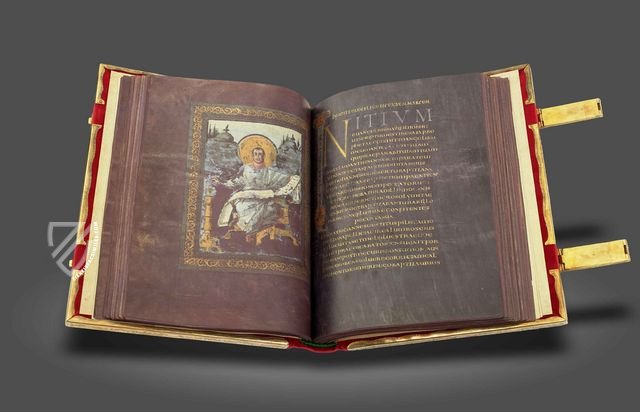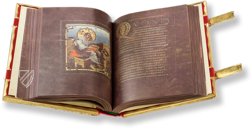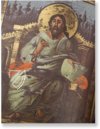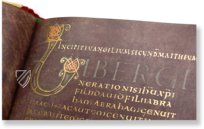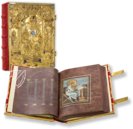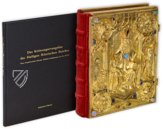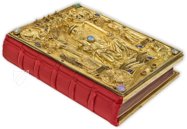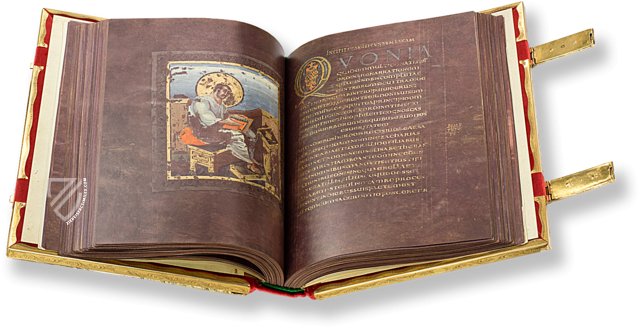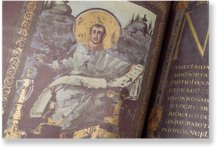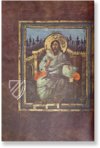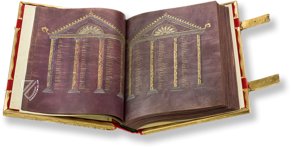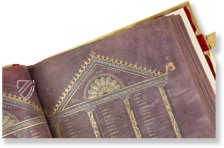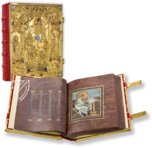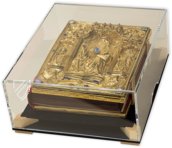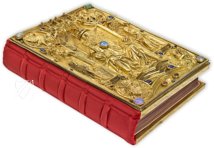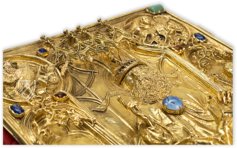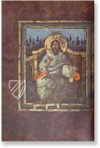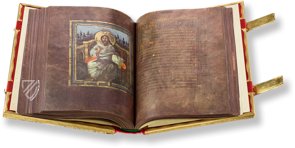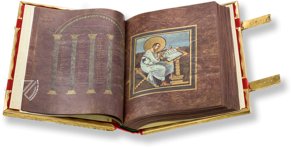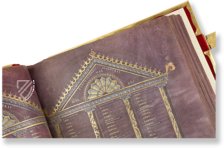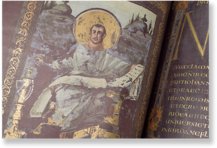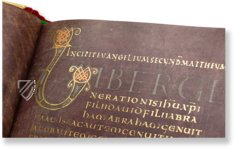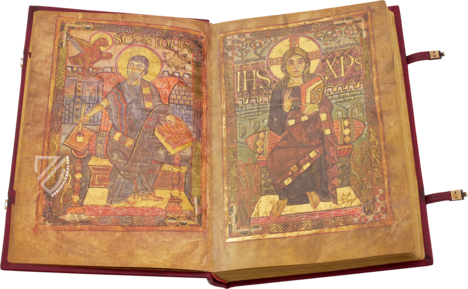Coronation Gospels
(over 10,000€)
The Coronation Gospels of the Holy Roman Empire, also known as the Vienna Coronation Gospels, represents a highpoint of Carolingian manuscript art. This work is centrally important, as it is one of the imperial crown jewels on which any of the Roman-German Kings must take their coronation oath. It is opulently appointed and arranged in an evangelistary fashion. Sixteen canonical panels, four evangelical paintings, and other artistic jewelry adorn the grandly crafted calligraphy, all of which is crowned by a lavishly expensive and artful cover. The masterfully crafted golden cover is a work Late Gothic goldsmithing by Hans von Reutlingen, who created 700 years later in the 15th Century in order to emphasize the significance of the Coronation Gospels.
Coronation Gospels
The Coronation Gospels of the Holy Roman Empire, also known as the Vienna Coronation Gospels, represents a highpoint of Carolingian manuscript art. This work is centrally important, as it is one of the imperial crown jewels on which any of the Roman-German Kings must take their coronation oath. It is opulently appointed and arranged in an evangelistary fashion. Sixteen canonical panels, four evangelical paintings, and other artistic jewelry adorn the grandly crafted calligraphy, all of which is crowned by a lavishly expensive and artful cover.
Precious Materials and Art in the Ancient Tradition
The Coronation Gospels of the Holy Roman Empire is a tremendous work of inestimable significance. All of the 236 pages are purple parchment, a writing material of the highest worth and also therefore possessing great symbolism, the luxury manuscript contains the four Gospels, each prefaced with an Evangelist portrait. Throughout these fine purple pages, the biblical passages are written in gold and silver, with each Gospel text prefaced by a great initial. The Four Evangelist paintings most likely originate from various hands, who nonetheless attempted uniformity in style as they aimed to mimic the ancient painting techniques in their depiction of bodies and space. Wrapped in supple white raiment, the Evangelists are enthroned like ancient philosophers in the middle of the paintings, with a wide landscape and endless sky in the background. The artists of this manuscript, who presumably were from the Byzantine world, were part of Charlemagne's Palace School in Aachen .The 16 canonical archways are similarly underlined with the architectural elements of a combined ancient and medieval character.
The Binding
The magnificent binding of this manuscript catches one’s eye from the very first glance. The masterfully crafted golden cover is a work Late Gothic goldsmithing by Hans von Reutlingen, who created 700 years later in the 15th Century in order to emphasize the significance of the Coronation Gospels. A delicate relief with image of God the Father on His throne is in the middle of the scene of Annunciation, surrounded by the four Evangelist symbols in the corners, decorates the writing within. In this fine handmade work of craftsmanship, the glory of the gold is strengthened by the illumination of small diamond shards, with much more attention focused on the sapphire placed on the chest of God.
Historical Significance
Created ca. 800 at the behest of Charlemagne, this manuscript was used for centuries in the coronation of all Roman-German king, all of which took place in Aachen until 1531. The candidates took their oath on the codex by placing their hand on the opening page of the Gospel of John as they took their oath. A legendary event illustrates the importance of the manuscript: according to legend, when the tomb of Charlemagne was opened in the year 1000, the coronation gospel lay on his knees. As a result, it was revered in Aachen as a relic of Charles and to Vienna in 1811 reached Paderborn, where it is kept today together with the other imperial jewels. The magnificent cover is exhibited in the treasury of the Kunsthistorisches Museum as a highlight of the collection, the manuscript itself is too fragile for permanent exhibition after more than 12 centuries and is kept as a valuable treasure in a climate controlled safe.
Codicology
- Alternative Titles
- Codex Aureus
Krönungsevangeliar des Heiligen Römischen Reiches
Coronation Gospels of Charlemagne
Vienna Coronation Gospels
Treasury Gospels
Krönunsgevangeliar Karls des Großen
Wiener Krönungsevangeliar
Coronation Gospels of the Holy Roman Empire - Size / Format
- 472 pages / 34.0 × 26.5 cm
- Origin
- Germany
- Date
- Shortly before 800
- Epochs
- Style
- Genre
- Language
- Illustrations
- 16 canon tables, 4 full-page evangelist portraits, and 4 large decorative initials
- Patron
- Charlemagne (747–814)
- Artist / School
- Demetrius presbyter, a Byzantine artist in the court of Charlemagne (scribe and/or illuminator)
Hans von Reutlingen (1465–1547) (goldsmith of the cover) - Previous Owners
- Emperor Otto III (980–1002)
Coronation Gospels
Incipit Page: Gospel of Luke
Adorned by a glorious “Q” initial with Insular-style interlace, the opening lines of the Gospel of Luke are perfectly written. The Byzantine scribe’s triumph is all the more impressive considering that the words of the Four Evangelists were written entirely in gold ink, which contrasts wonderfully with the purple parchment that was itself extremely expensive to manufacture. Three writing styles were employed: capitalis rustica, capitalis quadrata, and uncial script for the main text.

Coronation Gospels
Portrait of John the Evangelist
During their coronations, candidates would swear their solemn oaths by laying their hand upon the Gospel of John. Such Evangelist portraits were a defining feature of Carolingian art, mixing Insular influences with Byzantine ones. This miniature is believed to have been made by a monk named Demetrius who, judging by the design, must have been classically trained in Italy.
Usually depicted as either a white-haired old man or a beardless youth, John is depicted as a man in his prime here. He faces the beholder directly and is seated in front of a classical architecture wearing a toga. He holds a pen or stylus in his right hand, which is gilded along with his halo, the frame, and the background, while holding his Gospel in his left hand.
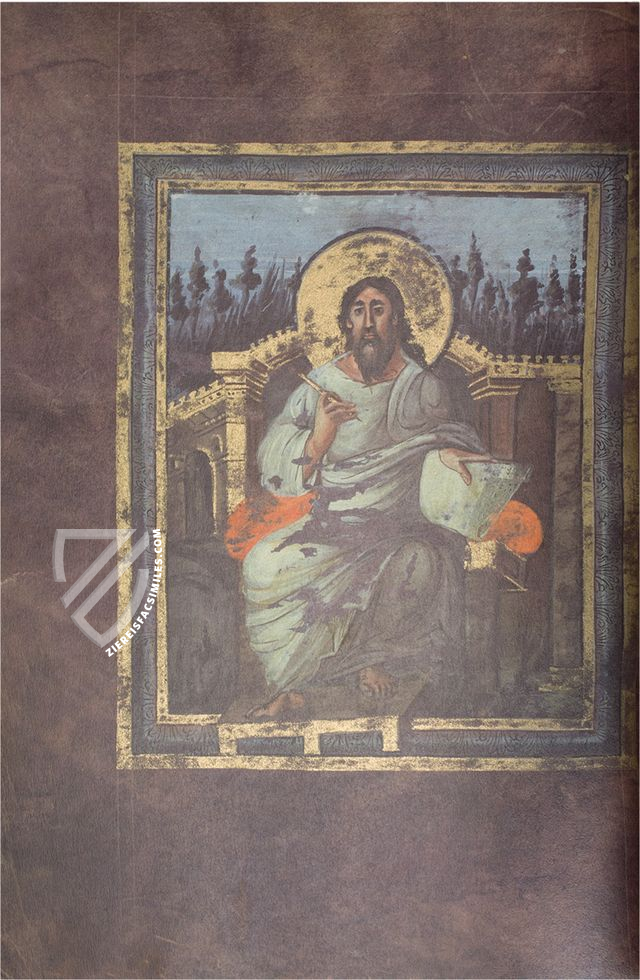
#1 Krönungsevangeliar des Heiligen Römischen Reiches (De Luxe Edition)
Language: German
(over 10,000€)
#2 Krönungsevangeliar des Heiligen Römischen Reiches (Library Binding Edition)
Language: German
(over 10,000€)
- Treatises / Secular Books
- Apocalypses / Beatus
- Astronomy / Astrology
- Bestiaries
- Bibles / Gospels
- Chronicles / History / Law
- Geography / Maps
- Saints' Lives
- Islam / Oriental
- Judaism / Hebrew
- Single Leaf Collections
- Leonardo da Vinci
- Literature / Poetry
- Liturgical Manuscripts
- Medicine / Botany / Alchemy
- Music
- Mythology / Prophecies
- Psalters
- Other Religious Books
- Games / Hunting
- Private Devotion Books
- Other Genres
- Afghanistan
- Armenia
- Austria
- Belgium
- Colombia
- Croatia
- Cyprus
- Czech Republic
- Denmark
- Egypt
- Ethiopia
- France
- Germany
- Greece
- Hungary
- India
- Iran
- Iraq
- Israel
- Italy
- Japan
- Lebanon
- Luxembourg
- Mexico
- Morocco
- Netherlands
- Palestine
- Peru
- Poland
- Portugal
- Russia
- Serbia
- Spain
- Sri Lanka
- Sweden
- Switzerland
- Syria
- Turkey
- Ukraine
- United Kingdom
- United States
- Uzbekistan
- Aboca Museum
- Ajuntament de Valencia
- Akademie Verlag
- Akademische Druck- u. Verlagsanstalt (ADEVA)
- Aldo Ausilio Editore - Bottega d’Erasmo
- Alecto Historical Editions
- Alkuin Verlag
- Almqvist & Wiksell
- Amilcare Pizzi
- Andreas & Andreas Verlagsbuchhandlung
- Archa 90
- Archiv Verlag
- Archivi Edizioni
- Arnold Verlag
- ARS
- Ars Magna
- ArtCodex
- AyN Ediciones
- Azimuth Editions
- Badenia Verlag
- Bärenreiter-Verlag
- Belser Verlag
- Belser Verlag / WK Wertkontor
- Benziger Verlag
- Bernardinum Wydawnictwo
- BiblioGemma
- Biblioteca Apostolica Vaticana (Vaticanstadt, Vaticanstadt)
- Bibliotheca Palatina Faksimile Verlag
- Bibliotheca Rara
- Boydell & Brewer
- Bramante Edizioni
- Bredius Genootschap
- Brepols Publishers
- British Library
- C. Weckesser
- Caixa Catalunya
- Canesi
- CAPSA, Ars Scriptoria
- Caratzas Brothers, Publishers
- Carus Verlag
- Casamassima Libri
- Chavane Verlag
- Christian Brandstätter Verlag
- Circulo Cientifico
- Club Bibliófilo Versol
- Club du Livre
- CM Editores
- Collegium Graphicum
- Collezione Apocrifa Da Vinci
- Comissão Nacional para as Comemorações dos Descobrimentos Portugueses
- Coron Verlag
- Corvina
- CTHS
- D. S. Brewer
- Damon
- De Agostini/UTET
- De Nederlandsche Boekhandel
- De Schutter
- Deuschle & Stemmle
- Deutscher Verlag für Kunstwissenschaft
- DIAMM
- Droz
- E. Schreiber Graphische Kunstanstalten
- Ediciones Boreal
- Ediciones Grial
- Ediclube
- Edições Inapa
- Edilan
- Editalia
- Edition Deuschle
- Edition Georg Popp
- Edition Leipzig
- Edition Libri Illustri
- Editiones Reales Sitios S. L.
- Éditions de l'Oiseau Lyre
- Editions Medicina Rara
- Editorial Casariego
- Editorial Mintzoa
- Editrice Antenore
- Editrice Velar
- Edizioni Edison
- Egeria, S.L.
- Eikon Editores
- Electa
- Emery Walker Limited
- Enciclopèdia Catalana
- Eos-Verlag
- Ephesus Publishing
- Ernst Battenberg
- Eugrammia Press
- Extraordinary Editions
- Fackelverlag
- Facsimila Art & Edition
- Facsimile Editions Ltd.
- Facsimilia Art & Edition Ebert KG
- Faksimile Verlag
- Feuermann Verlag
- Folger Shakespeare Library
- Franco Cosimo Panini Editore
- Friedrich Wittig Verlag
- Fundación Hullera Vasco-Leonesa
- G. Braziller
- Gabriele Mazzotta Editore
- Gebr. Mann Verlag
- Gesellschaft für graphische Industrie
- Getty Research Institute
- Giovanni Domenico de Rossi
- Giunti Editore
- Graffiti
- Grafica European Center of Fine Arts
- Guido Pressler
- Guillermo Blazquez
- Gustav Kiepenheuer
- H. N. Abrams
- Harrassowitz
- Helikon
- Hendrickson Publishers
- Henning Oppermann
- Herder Verlag
- Hes & De Graaf Publishers
- Hoepli
- Holbein-Verlag
- Hortus Deliciarum
- Houghton Library
- Hugo Schmidt Verlag
- Idion Verlag
- Il Bulino, edizioni d'arte
- ILte
- Imago
- Insel Verlag
- Instituto Nacional de Antropología e Historia
- Istituto dell'Enciclopedia Italiana - Treccani
- Istituto Ellenico di Studi Bizantini e Postbizantini
- Istituto Geografico De Agostini
- Istituto Poligrafico e Zecca dello Stato
- Italarte Art Establishments
- J. Thorbecke
- Jan Thorbecke Verlag
- Johnson Reprint Corporation
- Josef Stocker
- Josef Stocker-Schmid
- Jugoslavija
- Karl W. Hiersemann
- Kasper Straube
- Kaydeda Ediciones
- Kindler Verlag / Coron Verlag
- Kodansha International Ltd.
- Konrad Kölbl Verlag
- Kurt Wolff Verlag
- La Liberia dello Stato
- La Linea Editrice
- La Meta Editore
- Lambert Schneider
- Landeskreditbank Baden-Württemberg
- Leo S. Olschki
- Les Incunables
- Library of Congress
- Libreria Musicale Italiana
- Lichtdruck
- Lito Immagine Editore
- Lumen Artis
- Lund Humphries
- M. Moleiro Editor
- Maison des Sciences de l'homme et de la société de Poitiers
- Manuscriptum
- Martinus Nijhoff
- Maruzen-Yushodo Co. Ltd.
- MASA
- McGraw-Hill
- Militos
- Millennium Liber
- Müller & Schindler
- Nahar and Steimatzky
- National Library of Wales
- Neri Pozza
- Nova Charta
- Oceanum Verlag
- Odeon
- Orbis Mediaevalis
- Orbis Pictus
- Österreichische Staatsdruckerei
- Oxford University Press
- Pageant Books
- Parzellers Buchverlag
- Patrimonio Ediciones
- Pattloch Verlag
- PIAF
- Pieper Verlag
- Plon-Nourrit et cie
- Prestel Verlag
- Princeton University Press
- Prisma Verlag
- Priuli & Verlucca, editori
- Pro Sport Verlag
- Propyläen Verlag
- Pytheas Books
- Quaternio Verlag Luzern
- Reales Sitios
- Recht-Verlag
- Reichert Verlag
- Reichsdruckerei
- Riehn & Reusch
- Roberto Vattori Editore
- Rosenkilde and Bagger
- Roxburghe Club
- Salerno Editrice
- Sarajevo Svjetlost
- Schöck ArtPrint Kft.
- Scolar Press
- Scrinium
- Scripta Maneant
- Scriptorium
- Siloé, arte y bibliofilia
- SISMEL - Edizioni del Galluzzo
- Sociedad Mexicana de Antropología
- Société des Bibliophiles & Iconophiles de Belgique
- Soncin Publishing
- Sorli Ediciones
- Stainer and Bell
- Studer
- Styria Verlag
- Sumptibus Pragopress
- Szegedi Tudomànyegyetem
- Taberna Libraria
- Tarshish Books
- Taschen
- Tempus Libri
- Testimonio Compañía Editorial
- Thames and Hudson
- The Clear Vue Publishing Partnership Limited
- The Facsimile Codex
- The Folio Society
- The Marquess of Normanby
- The Richard III and Yorkist History Trust
- Tip.Le.Co
- TouchArt
- TREC Publishing House
- TRI Publishing Co.
- Trident Editore
- Typis Regiae Officinae Polygraphicae
- Union Verlag Berlin
- Universidad de Granada
- University of California Press
- University of Chicago Press
- Urs Graf
- Vallecchi
- Van Wijnen
- VCH, Acta Humaniora
- VDI Verlag
- VEB Deutscher Verlag für Musik
- Verlag Anton Pustet / Andreas Verlag
- Verlag Bibliophile Drucke Josef Stocker
- Verlag der Münchner Drucke
- Verlag für Regionalgeschichte
- Verlag Styria
- Vicent Garcia Editores
- W. Turnowsky
- Waanders Printers
- Wiener Mechitharisten-Congregation (Wien, Österreich)
- Wissenschaftliche Buchgesellschaft
- Wydawnictwo Dolnoslaskie
- Xuntanza Editorial
- Zakład Narodowy
- Zollikofer AG

